
Pat Shaughnessy《Ruby Under a Microscope》
书刊介绍
内容简介
How Ruby Works Under the Hood
Ruby is a powerful programming language with a focus on simplicity, but beneath its elegant syntax it performs countless unseen tasks.
Ruby Under a Microscope gives you a hands-on look at Ruby’s core, using extensive diagrams and thorough explanations to show you how Ruby is implemented (no C skills required). Author Pat Shaughnessy takes a scientific approach, laying out a series of experiments with Ruby code to take you behind the scenes of how programming languages work. You’ll even find information on JRuby and Rubinius (two alternative implementations of Ruby), as well as in-depth explorations of Ruby’s garbage collection algorithm.
Ruby Under a Microscope will teach you:
How a few computer science concepts underpin Ruby’s complex implementation
How Ruby executes your code using a virtual machine
How classes and modules are the same inside Ruby
How Ruby employs algorithms originally developed for Lisp
How Ruby uses grammar rules to parse and understand your code
How your Ruby code is translated into a different language by a compiler
No programming language needs to be a black box. Whether you’re already intrigued by language implementation or just want to dig deeper into Ruby, you’ll find Ruby Under a Microscope a fascinating way to become a better programmer.
Covers Ruby 2.x, 1.9 and 1.8
作品目录
Foreword by Aaron Patterson
Acknowledgments
Introduction
Chapter 1: Tokenization and Parsing
Chapter 2: Compilation
Chapter 3: How Ruby Executes Your Code
Chapter 4: Control Structures and Method Dispatch
Chapter 5: Objects and Classes
Chapter 6: Method Lookup and Constant Lookup
Chapter 7: The Hash Table: The Workhorse of Ruby Internals
Chapter 8: How Ruby Borrowed a Decades-Old Idea from Lisp
Chapter 9: Metaprogramming
Chapter 10: JRuby: Ruby on the JVM
Chapter 11: Rubinius: Ruby Implemented with Ruby
Chapter 12: Garbage Collection in MRI, JRuby, and Rubinius
Index
相关推荐
-

数据库可靠性工程:数据库系统设计与运维指南
《数据库可靠性工程:数据库系统设计与运维指南》内容简介:数据是当今企业的宝贵资产,设计、构建并维护数据存储的重要性不言而喻
-
![[美] 乔纳森·利特曼《创新的艺术》](http://oss.shudanhao.com/caiji/chazidian/2023/291.jpg)
[美] 乔纳森·利特曼《创新的艺术》
作家加里·哈梅尔的预测尖锐地指出了所有公司面临的挑战——商场逐鹿中,只有疾速创新才能立于不败之地。美国著名设计公司IDEO的
-

超级搜索术
《超级搜索术》内容简介:如何报高考志愿?要不要现在换工作?如何租房?要不要现在买房?如何快速获得行业报告?如何判断药是否对
-

重构 改善既有代码的设计
重构 改善既有代码的设计 本书特色本书清晰揭示了重构的过程,解释了重构的原理和*佳实践方式,并给出了何时以及何地应该开始挖掘代码以求改善。书中给出了70 多个可...
-

如厕书
《如厕书》内容简介:31个发生在厕所的神奇小故事,一部充满想象力的短篇小说集! 家庭主妇销毁偷吃证据,职员被困马桶尴尬时刻,甚
-

电子商务网页设计
《电子商务网页设计》内容简介:本书针对中等职业学校电子商务专业和计算机类专业的网页设计与制作的教材或参考书,共分十二个项目
-
![[日] 早川由美《造物的日常》](http://oss.shudanhao.com/caiji/chazidian/2023/37338.jpg)
[日] 早川由美《造物的日常》
一家4口、9只鸡、1条狗、18年。制衣、种菜、捏陶、采蜜、去旅行……《造物的日常》是早川由美的手绘生活笔记,她在书中将自己根植
-

助推:快与慢
《助推:快与慢》内容简介:行为经济学的政策观强调对社会成员的社会偏好的激发,而不是完全依赖物质奖惩。行为经济学家并不否认理
-

极简谈判术:突破常规思维的7个关键
《极简谈判术:突破常规思维的7个关键》内容简介:本书针对初阶谈判,打造人人都可以掌握的极简谈判术。作者从现实案例出发,分析问
-

瑞士银行秘密
《瑞士银行秘密》内容简介:银行业变革一直是近些年的热点话题。世界很大的离岸金融中心瑞士银行以拥有数百年的保密传统而享有盛誉
-

徐胜《游戏外挂攻防艺术》
随着网络的普及,网络游戏得到了众多网民的青睐。但是,网络游戏的盛行,也给游戏玩家和游戏公司带来了很多安全问题,如木马盗号
-

港澳发展研究
《港澳发展研究》内容简介:《港澳发展研究》是清华大学港澳研究中心首批立项项目的集结展示,分为“一带一路”与港澳研究、法律政
-

计算机主板维修不是事儿(第2版)
《计算机主板维修不是事儿(第2版)》内容简介:本书是计算机主板芯片级维修的技术指导参考书,从电路基础、电路工作原理到维修思路
-

阿里铁军销售课
《阿里铁军销售课》内容简介:什么是销售? 我们每天都在销售和被销售,销售已经成为一种意识,是一种思维。本书作者“阿里军校”首
-

计算广告(第2版)
《计算广告(第2版)》内容简介:计算广告是一项新兴的研究课题,它涉及大规模搜索和文本分析、信息获取、统计模型、机器学习、分类
-

Felicia Lowenstein Niven《Lo Que Hacen los Doctores/What Doctors Do》
Whatdoesittaketobecomeadoctor,andhowdotheykeepushealthy?Learnhowlongdoctorshavet...
-

Web GIS从基础到开发实践
《Web GIS从基础到开发实践》内容简介:本书适合政府、企业相关部门的GIS研究与开发人员,以及高等院校地理学、地理信息系统、房地
-

直播修炼手册
《直播修炼手册》内容简介:《直播修炼手册:主播IP打造+营销运营+商业变现》是一本直播修炼宝典,从主播的IP打造到营销推广、整体
-

《Algorithms to Live By》书籍《Algorithms to Live By》
Afascinatingexplorationofhowinsightsfromcomputeralgorithmscanbeappliedtoourevery...
-

实用礼仪教程(第四版)
《实用礼仪教程(第四版)》内容简介:本书对学生实际学习生活礼仪的各个方面,特别是按照学习生活的不同场景对形象礼仪规范及行为





